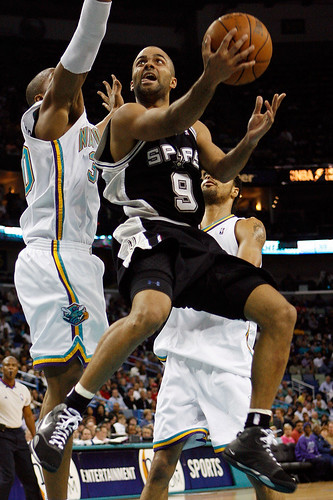By Jordan Rivas, Staff Writer Project Spurs
Over the course of a player’s career, things can change. Even from one year to the next their performance can fluctuate and our expectations can shift. We find the metamorphosis fascinating. We’ve had the chance to watch a few Spurs players progress through their first steps in the league until now. Some turned out how we expected. For better or worse, some didn’t.
Over the next four weeks, we’re going to bring you other thoughts on the “Then and Now” of their respective careers.
Enjoy.
I remember in the early part of 2002, during Tony Parker’s rookie campaign, I read an 
That was crazy, but people believed it. I was one of them. The next eight years taught me the errors of my short-sighted thinking and now we’ve got the All-Star point guard we all know and kind of love when we’re not ruthlessly raising expectations on him, again.
There are three things that distinguish the Tony Parker today from the one we first witnessed eight years ago.
That’s it – three. We could discuss some finer points in greater numbers, but all of Parker’s evolution can be captured in the following three areas:
- He couldn’t shoot.
- He wasn’t physical enough.
- He wasn’t in control of the offense.
Parker couldn’t shoot when he got here. Remember the awkward, nearly flat footed jump shot? And it wasn’t like that weird Peja Stojakovic shot that goes in all the time. It was like that “your organization is going to buy you a shooting coach so other teams will stop laughing at us” kind of shot. It affected everything Parker was doing on offense.
The line on Parker became sadly concise, “he’s fast and can get by anybody, but he can’t shoot. Just play off him.” It defined how defenses guarded him and consequently defined how he played.

On the physicality note, Parker simply didn’t have the strength, particularly in his upper 
It’s significant because there’s a world of difference between a quick, light guard and a quick, powerful guard. It’s not that success is reserved for one or the other, but it was clear that a team structured around a hall of fame big man wasn’t going to have the kinds of open lanes conducive to a more finesse guard. Parker was always going to need more strength to be a go-to option offensively. And the added strength, coupled with his natural quickness, has made him a reliable defender against top flight guards.
When you see Parker push ahead on the break and finish, you may think it’s the speed that does it, but it’s the strength that let’s him finish on more than one defender. There’s a world of difference between where Parker was and where he is now largely due to his added physicality.
Lastly is Parker’s maturation into a true floor general. When Parker first started with the Spurs he was merely a relay switch for the offense for coach Pop. The offense ran from the sidelines and it showed. Parker was never overly selfish or a terrible decision maker, but the offense didn’t flow out of his hands the way it does now.
At first, Parker wasn’t calling plays; then he was calling plays; and now he’s the driving force creating the offense. He’s gone beyond just running the offense. He has put himself in into a category of a only a few lead guards who are truly the catalyst for their team’s offense.
Where does Parker go from here?
I once told someone, if Parker isn’t the best point guard in the league at some point in his career I’ll consider him a disappointment. Considering the three championships rings he’s earned so far, I don’t think that’s a fair assessment anymore. But on some level, Spurs fans still expect that level of individual dominance from him.
So how does he get there?
Right now I consider Chris Paul of New Orleans and Deron Williams of Utah to be ranked 
Oh, and he’s going to have to keep winning rings. But so far he seems to have that part down.
Add The Sports Daily to your Google News Feed!